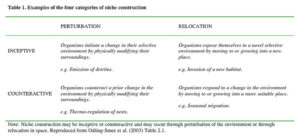Organisms adapt to their environments through natural selection. However, they also choose and modify aspects of their world, and thereby modify natural selection. In this way they influence evolution.
Niche construction is the process whereby organisms transform environmental states and choose resources, thereby modifying the natural selection that they (and other organisms exposed to the modified conditions) experience.
Examples of niche construction include the building of nests and burrows by animals and alterations of nutrient cycling by plants.
By transforming natural selection, niche construction generates feedback in evolution. Niche construction also plays a critical role in ecology by affecting the flows of energy and nutrients through ecosystems.
In addition, niche construction theory has had an impact on a variety of disciplines, including the human sciences (e.g. archaeology, biological anthropology, human evolution), developmental biology and medicine, and climate change, biodiversity and conservation.
The following criteria test for the presence of niche construction (Criteria 1 and 2) and determine when niche construction affects evolution (Criterion 3):
Criterion 1) An organism (i.e., a candidate niche constructor) must significantly modify environmental conditions.
Criterion 2) The organism-mediated environmental modifications must influence selection pressures on a recipient of niche construction.
Criterion 3) There must be a detectable evolutionary response in a recipient of niche construction that is caused by the environmental modification of the niche constructor.
Organisms modify the selection that they experience both through physically changing their environments (‘perturbational niche construction’Organisms physically change one or more components of their external environments.) and habitat choice (‘relocational niche construction’Organisms actively move in space, as well as choose or bias the direction, the distance in space through which they travel, and the time when they travel, thereby modifying natural selection.). Their activities can create novel selection (‘inceptive niche construction’Organisms either perturb their environments, or move, to introduce a new change in one or more natural selection pressures.) or respond to existing selection (‘counteractive niche construction’Organisms either perturb their environments, or move in space, to wholly or partly reverse or neutralise some prior change in their environment.).

[accordions_pplugins id=’150′]
The niche-construction perspective was introduced to evolutionary biology through pioneering writings by Conrad Waddington and Richard Lewontin and is distinctive in treating niche construction as a fundamental evolutionary process in its own right.
[pic of Lewontin and Waddington]
The standpoint is encapsulated in the below quote from biologists Richard Levins and Richard Lewontin (1985, p106):
The organism influences its own evolution, by being both the object of natural selection and the creator of the conditions of that selection.
This stance contrasts with the conventional perspective by placing emphasis on the capacity of organisms to modify environmental states. In so doing, organisms co-direct their own evolution, often but not exclusively in a manner that suits their genotypes. Through their niche construction, organisms modify selection acting on themselves and other species that share their environment.
The niche construction perspective is aligned intellectually with other movements within evolutionary biology that are calling for an extended evolutionary synthesis.
[accordions_pplugins id=’6123′]
The scientific study of niche construction dates back to the early writings on ecological succession of William King in the 17th century. There were important 19th century contributions by Charles Darwin (1851) on corals and earthworms (1881), Lewis Henry Morgan (1868) on the beaver, Nathaniel Shaler’s (1892) analyses of how animals affect soils, and Frederic Clements’ (1916) classic work on plant ecological succession.
Image of Darwin and/or earthworm coral books |
Important 20th century contributions to niche construction theory were made by physicist Erwin Schrodinger, developmental biologist Conrad Waddington, evolutionary biologists Richard Lewontin and John Odling-Smee.
Visual representation of a historical timeline |
Image of Darwin and/or earthworm coral books
[accordions_pplugins id=’6139′]